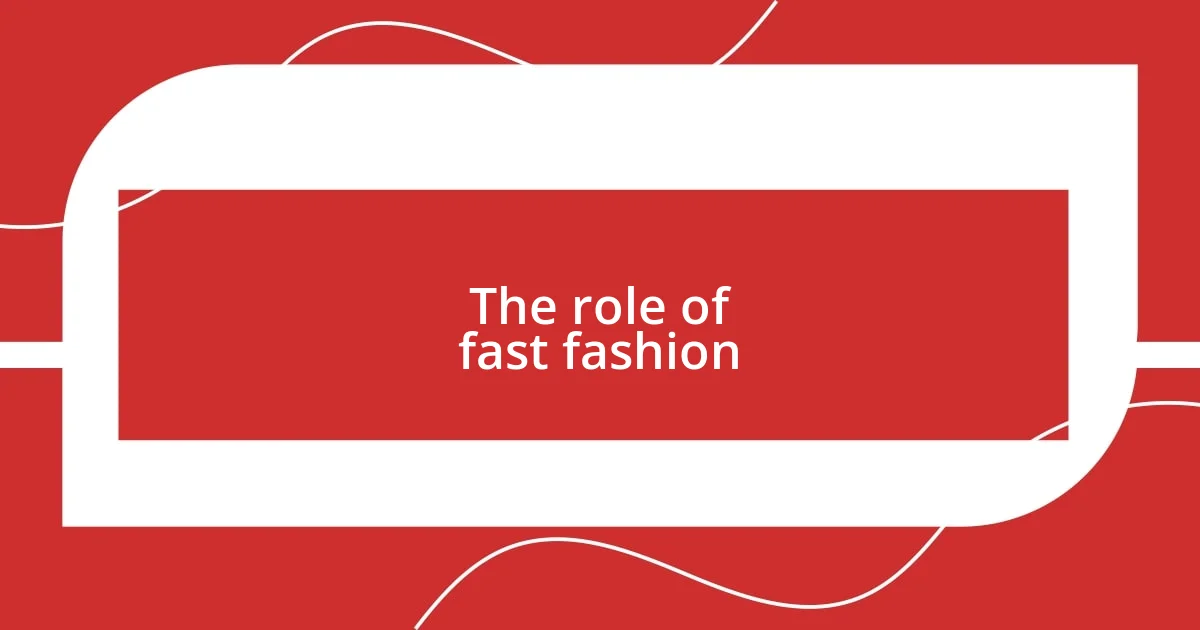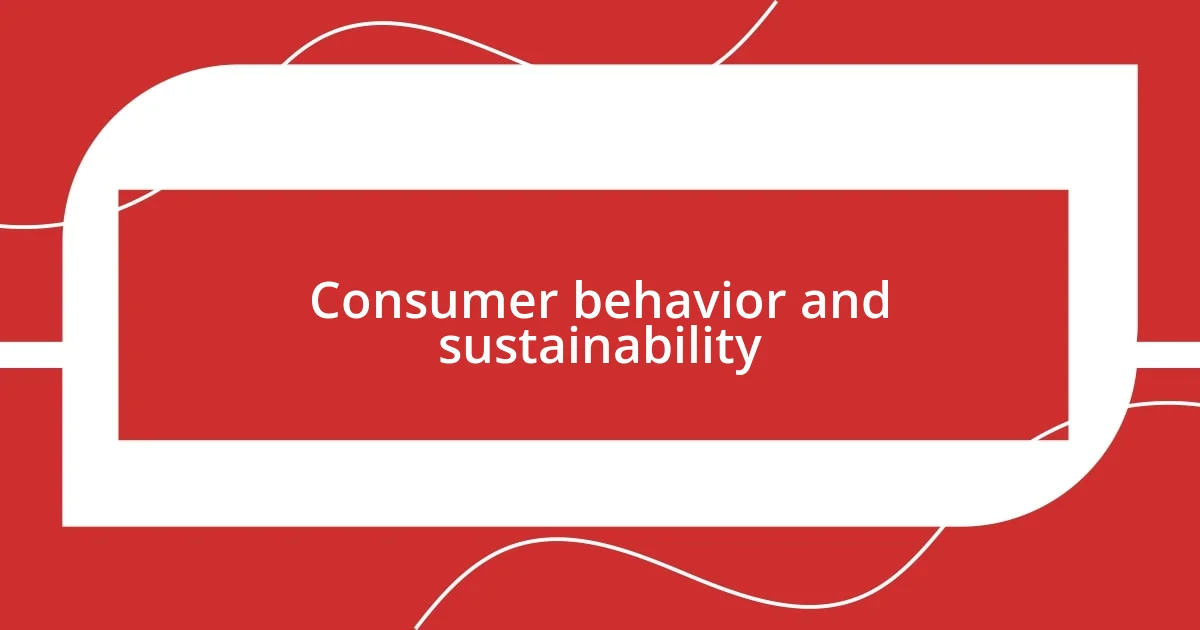Key takeaways:
- Fashion sustainability faces challenges such as environmental impact, consumer behavior in fast fashion, and lack of supply chain transparency.
- The fashion industry contributes to significant waste, pollution, and carbon emissions, demanding a reassessment of shopping habits.
- Innovative solutions like using recycled materials, clothing swaps, and technology (e.g., 3D printing) are emerging to promote sustainable practices in fashion.

Understanding fashion sustainability challenges
One of the biggest challenges in fashion sustainability is understanding the environmental impact of production processes. I recall visiting a textile factory and being struck by the sheer amount of water used—water that’s often polluted and left untreated. Isn’t it alarming to think that the clothes we wear could contribute to such waste?
Another challenge lies in consumer behavior; we’re often caught in the cycle of fast fashion. I’ve personally felt the thrill of buying something trendy, only to find it discarded a few months later. Why is it so hard for us to shift our mindset towards lasting quality over fleeting trends?
Additionally, the supply chain transparency can be a daunting hurdle. I once stumbled upon a local brand that claimed sustainability, but a closer look revealed gaps in their sourcing practices. How can we, as conscious consumers, truly know what we’re supporting without digging deeper into the brand’s story?

Key environmental impacts of fashion
Fashion has a significant environmental footprint, impacting everything from air and water quality to land use. I specifically remember reading about the staggering figure of nearly 92 million tons of textile waste produced annually. It’s disheartening to realize that much of this waste ends up in landfills, where it can take decades to decompose.
Here are some of the key environmental impacts of the fashion industry:
-
Water Consumption: The production of a single cotton shirt can use up to 2,700 liters of water, which is equivalent to what one person drinks in about 2.5 years.
-
Pollution: Textile dyeing is responsible for 20% of global water pollution; toxic chemicals used in this process often end up in rivers and oceans.
-
Carbon Emissions: The fashion industry contributes around 10% of global carbon emissions, largely due to greenhouse gases released from production, transportation, and disposal methods.
-
Waste Generation: Clothing waste is projected to increase to 134 million tons by 2030, as consumers continue to buy more fast-fashion items that are worn only a few times.
-
Microfiber Pollution: Washing synthetic fabrics releases millions of microfibers—tiny plastic particles—into waterways, posing a threat to marine life and ecosystems.
Seeing these figures definitely gives one pause, doesn’t it? It’s a wake-up call to reconsider not just our shopping habits but the entire lifecycle of our clothes.

The role of fast fashion
Fast fashion plays a pivotal role in the current fashion landscape, often prioritizing rapid production and low costs over sustainability. I remember the excitement of thrifting an outfit that seemed chic and fresh, only to discover later that it’s part of a broader issue, contributing to a cycle of disposability. The thrill of fast fashion can feel irresistible, yet it masks the reality of overconsumption and environmental neglect.
The sheer speed at which fast fashion operates is astonishing. I once watched a documentary highlighting how some brands release new collections multiple times a week. It struck me as more than just a marketing strategy; it’s a relentless push that conditions us as consumers to view clothing as disposable. How can we break away from this cycle when we’re constantly bombarded with new trends?
Moreover, the workforce behind fast fashion often endures harsh conditions, reflecting an alarming disregard for human dignity. During a conversation with a friend who traveled to a manufacturing hub, I learned about the long hours and minimal wages faced by workers. It left me wondering—what sacrifices are we willing to make in the name of fleeting trends? It’s essential to consider not just our impact on the environment, but the lives affected by the industry we’re a part of.
| Aspect | Fast Fashion |
|---|---|
| Production Speed | Rapid production cycles (multiple collections weekly) |
| Environmental Impact | High waste generation and pollution |
| Worker Conditions | Often poor labor practices and low wages |

Consumer behavior and sustainability
When it comes to consumer behavior, I’ve noticed that our buying habits often reflect a deeper disconnect from the consequences of our choices. I distinctly recall a shopping trip where I filled my cart with vibrant items, only to later realize I was caught in the trap of trends, leaving behind thoughts of sustainability. This fleeting excitement contributes to a culture of overconsumption, making it imperative for us to think critically about what we purchase and why.
I sometimes wonder how many people truly understand the impacts of their fashion choices. It’s not just about looking good; it’s about the environmental toll behind each garment. For instance, after watching a documentary about textile waste, I felt a sense of guilt about my own wardrobe, knowing it resembled a collection of fast-fashion regrets. This epiphany made me consider—what if we all paused before clicking “buy” and asked ourselves, Do I need this? How will it affect our planet?
Interestingly, I’ve found that sustainable practices can also stem from simply changing our mindset. Instead of adopting that “wear it once” mentality, I’ve embraced a more thoughtful approach, opting for quality pieces that tell a story and last longer. Let’s face it, when we engage more mindfully with our clothing, we can make choices that not only reflect our identity but also care for the world we live in. How can cultivating this mindset lead to a more sustainable future? I believe it starts with recognizing that every purchase is a vote for the kind of fashion industry we want to support.

Innovative solutions for sustainable fashion
Exploring innovative solutions for sustainable fashion reveals some truly exciting initiatives that are rising to the challenge. I recently came across a brand that uses recycled ocean plastics to create stunning clothing. It struck me how ingenuity can turn waste into fashion, and I couldn’t help but feel a sense of hope—it’s inspiring to see the industry shift towards alternatives that help tackle pollution, instead of worsening it.
I can’t shake the thrill I felt when I first attended a clothing swap event. Watching people exchange their once-loved items not only gave new life to garments but also fostered a sense of community. This practice highlights a simple truth: we can reduce waste by creatively refreshing our wardrobes through sharing rather than buying. Isn’t it fascinating how a social event can deliver a sustainable punch, making us rethink how we view our clothing options?
Moreover, I’m consistently intrigued by the rise of technology in sustainable fashion. For example, 3D printing is starting to revolutionize how we create apparel, reducing fabric waste significantly during the manufacturing process. I often wonder: could this be the key to merging style with sustainability? As these advancements continue, I believe we’re not just witnessing a change in how clothes are made but a transformation in how we think about them.

Best practices for ethical brands
Ethical brands shine when they prioritize transparency and traceability. I remember attending a pop-up shop for a local brand that revealed the story behind each piece—where the fabrics came from, who made them, and the fair wages they received. It was refreshing to see those connections laid bare, transforming a simple shopping experience into an educational journey. How often do we get the chance to know the hands that crafted our clothes?
Sustainable practices also extend to materials used. I tried a brand that focuses on organic cotton and sustainable fibers. The feeling of wearing these clothes was different; they felt lighter and more conscientious, almost as if they were whispering a promise to the planet. It got me thinking—how can the choice of fabric shape our relationship with our wardrobe? Each selection, from material to design, has the power to reflect a commitment to ethical practices.
Finally, engaging consumers through community initiatives can create a powerful bond. I distinctly recall a workshop I attended where we learned to repair our clothing instead of discarding them. It not only saved my favorite jacket but also instilled a sense of responsibility toward my purchases. Isn’t it remarkable how sharing skills like these fosters a culture of sustainability? I believe that when brands actively involve their customers in ethical practices, we create a ripple effect that can change the industry for the better.















